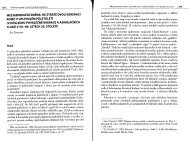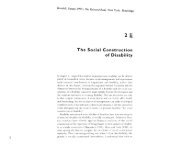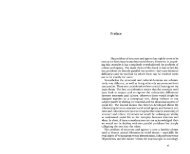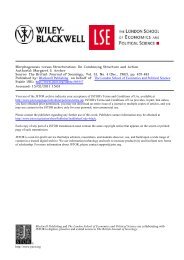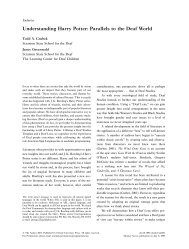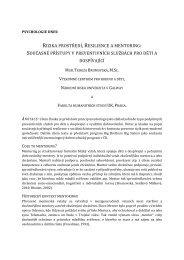Chapter <strong>Two</strong> 80 <strong>Culture</strong> <strong>and</strong> <strong>Practical</strong> <strong>Reason</strong><strong>Two</strong> <strong>Paradigms</strong> <strong>of</strong> Anthropological Theory81Studied alive myth ... is not symbolic, but a direct expression <strong>of</strong> itssubject matter; it is not an explanation in satisfaction <strong>of</strong> a scientificinterest, but a narrative resurrection <strong>of</strong> a primeval reality, told in satisfaction<strong>of</strong> deep religious wants, moral cravings, social submissions,assertions, even practical requirements [ibid., p. 10 I] .... We can Certainlydiscard all explanatory as well as all symbolic interpretations <strong>of</strong>these myths <strong>of</strong>origin. The personages <strong>and</strong> beings are what they appear tobe on the surface, <strong>and</strong> not symbols (If hidden realities. As to any explanatoryfunction <strong>of</strong> these myths, there is no problem which they cover, nocuriosity which they satisfy, no theory which they contain. [Ibid., p.126]This too was Malinowski's celebrated approach to language. Pace Boas,language contains no theory: it contains nothing <strong>and</strong> is nothing but a verbalgesture, "a 'grip' on things," whose meaning consists in the effects inducedupon the hearers. "Words are part <strong>of</strong> action <strong>and</strong> they are equivalentto actions" (Malinowski 1965 [1935] 2:9). And as words are action, meaningis the reaction evoked; the former is the stimulus, the latter the response;one is the instrument, the other its product:The meaning <strong>of</strong> a single utterance, which in such cases is <strong>of</strong>ten reducedto one word, can be defined as the change produced by thesound in the behavior <strong>of</strong> people. It is the manner in which a soundappropriately uttered is correlated with spatial <strong>and</strong> temporal elements<strong>and</strong> with human bodily movements which constitutes its meaning;<strong>and</strong> this is due to cultural responses produced by drill, or "conditioning"or education. A word is the condition!ng stimulus <strong>of</strong> humanaction <strong>and</strong> it becomes, as it were, a "grip" on things outside the reach<strong>of</strong> the speaker but within that <strong>of</strong> the hearers. [Ibid., p. 59]'9It is also entailed that meaning is limited to experience by association:that is, to an original <strong>and</strong> indexical reference which remains the basicconcept <strong>of</strong> the utterance through its subsequent reproductions. Rather thanclassifying experience, language for Malinowski is itself divided by experience.One word is differentiated from another as the real-world contextin which the first occurs is perceptibly distinguishable from the context <strong>of</strong>the second. "Language in its structure mirrors the real categories derivedfrom practical attitudes <strong>of</strong> the child <strong>and</strong> <strong>of</strong> primitive or natural man to thesurrounding world" (Malinowski 1949 [1923], pp. 327-28). This sort <strong>of</strong>ultimate refusal <strong>of</strong> the symbolic, <strong>of</strong> the word as category, led Malinowskiinto some choice bevues. One was "the doctrine <strong>of</strong> homonyms": sinceeach empirically distinct reference <strong>of</strong> a given word constitutes a distinctmeaning, Malinowski was obliged to conclude that the' 'word" in questionis really a number <strong>of</strong> different ones, an accidental set <strong>of</strong> homonyms,20 Ifsuch were the case, <strong>of</strong> course, neither words nor communication as weknow them could exist, inasmuch as the contexts <strong>of</strong> two different uses <strong>of</strong>the same word are never the same; hence each such sound is a different"unit" from every other-which is to say that there are no words but onlyan infinitude <strong>of</strong> fugitive contextual signals. Similar difficulties are posed by. the fact that two people can never experience the same reality in exactly thesame way, if they are in any way different themselves. Again, as "ultimatelyall meaning <strong>of</strong> words is derived from bodily experience,"Malinowski would insist that even the most abstract concepts, such asthose <strong>of</strong> science, really derive from commonplace or infantile praxis."Even the pure mathematician, dealing with the most useless <strong>and</strong> arrogantbranch <strong>of</strong> his learning, the theory <strong>of</strong> numbers, has probably had someexperience <strong>of</strong> counting his pennies <strong>and</strong> shillings or his boots <strong>and</strong> buns"(1965 [1935] 2:58). Malinowski here ignores the fact that the system <strong>of</strong>numbers must have antedated the counting, but this is the kind <strong>of</strong> error healways makes in his ontogenetic arguments (as <strong>of</strong> classificatory kinshippractice), confusing the way the individual is socialized into the systemwith the explanation-indeed the "origin"-<strong>of</strong> the system (cf.Malinowski 1930).21 Finally, Malinowski's concept <strong>of</strong> meaning is unable19. Malinowski developed this instrumental-pragmatic vie'N <strong>of</strong> language in a number <strong>of</strong>writings. For el\ample. in the article on "<strong>Culture</strong>" in the Encyclopaedia <strong>of</strong> the SocialSciences: "The meaning <strong>of</strong> a word is not mysteriously contained in it but is rather anactive effect <strong>of</strong> the sound uttered within the contel\t <strong>of</strong> situation. The uUerance <strong>of</strong> soundis a significant act indispensable in all forms <strong>of</strong> human concerted action. It is a type <strong>of</strong>behavior strictly comparable to the h<strong>and</strong>ling <strong>of</strong> a tool, the wielding <strong>of</strong> a weapon, theperformance <strong>of</strong> a ritual or the concluding <strong>of</strong> a contract. The use <strong>of</strong> words is in all theseforms <strong>of</strong> human activity an indispensable correlate <strong>of</strong> manual <strong>and</strong> bodily behavior"(Malinowski 1931, p. 622; cf. Malinowski 1949 (1923); 1964 (1936)). For a criticalaccount <strong>of</strong> Malinowski's theories <strong>of</strong> language, see Henson (1974).20. "In order to define a sound, we must discover, by careful scrutiny <strong>of</strong> verbal contel\ts inhow many distinguishable meanings it is used. Meaning is not somelhing which abideswithin a sound [i.e, not the Saussurean two sides <strong>of</strong> the paper); it el\ists in the sound'srelation to the contel\t. Hence if a word is used in a different contel\t it cannot havethe same meaning; it ceases 10 be one \''Ilrd <strong>and</strong> be
Chapter <strong>Two</strong> 82 <strong>Culture</strong> <strong>and</strong> <strong>Practical</strong> <strong>Reason</strong><strong>Two</strong> <strong>Paradigms</strong> <strong>of</strong> Anthropological Theory83to account for his own ethnographic project <strong>of</strong> making functional sense <strong>of</strong>exotic custom. For inasmuch as the ostensible form <strong>of</strong> these customs isstrange or even nonfunctional, Malinowski cannot be guided by experiencein his interpretation; or at least he must selectively categorize <strong>and</strong> valorizethe people's rational attitudes over their unreasonable behavior by a principlenot given with the ethnographic encounter. Malinowski held that theword does not embody any idea, that its meaning is external, in its empirical"effects." A sound ethnography, then, generated from a prolongedsocialization in Trobri<strong>and</strong> life, should be just what a Trobri<strong>and</strong>er wouldhave written. But if Malinowski is to "create them," he must organize hisethnographic experience by his concepts. And this he does by his ownadmission, if in contradiction to his notion that the word contains no idea:There is no such thing as a description completely devoid <strong>of</strong> theory.Whether you reconstruct historic scenes, carry out a field investigationin a savage tribe or a civilized community ... every statement <strong>and</strong>every argument has to be made in words, that is, in concepts. Eachconcept, in tum, is the result <strong>of</strong> a theory which declares that somefacts are relevant <strong>and</strong> others adventitious, that some factors determinethe course <strong>of</strong> events <strong>and</strong> others are merely accidental by-play; thatthings happen the way they do because personalities, masses, <strong>and</strong>material ~gencies <strong>of</strong> the environment. produced them. JMalinowski 1960(1944) p. 7]Ricoeur observes that in the strongest case <strong>of</strong> the word as praxis, the"imperative word," the "effect" requires the presence <strong>of</strong> symbolizingbeings in a symbolized context, as the "underst<strong>and</strong>ing" includes at once aproject <strong>and</strong> a system <strong>of</strong> valuations which differentiate the world <strong>and</strong> men'sactions in it. 22 One may make the same point in another way. It is easy tomathematics has been possible <strong>and</strong>, through it, mathematical physics <strong>and</strong> the techniquesresulting from successive industrial revolutions. It is striking that Plato contributed tothe construction <strong>of</strong> Euclidean geometry through his work <strong>of</strong> denominating such conceptsas line, surface, equality, <strong>and</strong> the similarity <strong>of</strong> figures, etc., which strictly forbade allrecourse <strong>and</strong> all allusion to manipulations, to physical transformations <strong>of</strong> figures. Thisasceticism <strong>of</strong> mathematical language, to which we owe, in the last analysis, all ourmachines since the dawn <strong>of</strong> the mechanical age, would have been impossible withoutthe logical heroism <strong>of</strong> a Parmenides denying the entirety <strong>of</strong> the world <strong>of</strong> becoming <strong>and</strong><strong>of</strong>praxis in the name <strong>of</strong> the self·identity <strong>of</strong> significations. It is to this denial <strong>of</strong> movement<strong>and</strong> work that we owe the achievements <strong>of</strong> Euclid, <strong>of</strong> Galileo, modemmechanism, <strong>and</strong> all our devices <strong>and</strong> apparatus. For within these, all our knowledge iscontracted, all the words which at first did not attempt to transform the world" (ibid.,pp. 201-2).22. "The word, we said, does not 'make' anything, at most it incites to action ... but if itincites to action this is because it signifies what is to be done <strong>and</strong> because the exigencysee in Malinowski's underst<strong>and</strong>ing <strong>of</strong> language as work <strong>and</strong> <strong>of</strong> meaning asthe response produced in the hearer, the same reduction <strong>of</strong> human subjectto manipulated object that informs his ethnographic technique. The Alter inthis conception is merely a means to an end, a raw material to be workedupon like any other. But again, as Ricoeur insists, the sequel to a remark inthe behavior <strong>of</strong> another is not the same kind <strong>of</strong> relation as the effect <strong>of</strong> atool on the shape <strong>of</strong> an object; it is not "produced" as a material good isproduced (1970, p, 203). Not merely because the Other is an intentionalbeing like myself, More decisively because the communication implies acommunity, <strong>and</strong> therefore the bringing to bear on the "effect" <strong>of</strong> all thosecommon conceptions <strong>of</strong> men <strong>and</strong> things which, ordering their interrelations,determine the specific "influence" <strong>of</strong> the word.Malinowski's elimination <strong>of</strong> symbol <strong>and</strong> system from cultural practices,this cannibalism <strong>of</strong> form by function, constitutes an epistemology for theelimination <strong>of</strong> culture itself as the proper anthropological object. Withoutdistinctive properties in its own right, culture has no title to analysis as athing-in-itself, Its study degenerates into one or another <strong>of</strong> two commonplacenaturalisms: the economism <strong>of</strong> the rationalizing individual (humannature); or the ecologism <strong>of</strong> selective advantage (external nature).Malinowski, <strong>of</strong> course, cannot be held responsible for inventing eitherproblematic, or for developing either to the full, but the first is definitelyembedded in his work as the second is there prefigured. The economism orutilitarianism develops from his distinction between cultural norm <strong>and</strong>subjective attitude, <strong>and</strong> from the submission, in his view, <strong>of</strong> the "ideal" toa pragmatic self-interest-which installs the latter as the true operator <strong>of</strong>social life.Malinowski could "see things as the natives saw them" provided, as itwere, they agreed to see things his way. They would have to incline to ananalysis which valued practical action over cultural norm, <strong>and</strong> again withregard to the action, the subjective affect over the ostensible form. ByMalinowski's notions, the rules were one thing but the actions another <strong>and</strong>truer one-the former mere talk to the latter's "reality," the norms havingsignified to another is 'understood' by him <strong>and</strong> 'followed' by him.... The word articulatesin phrases, verbs <strong>and</strong> nouns, adjecrives, complements, plurals, etc., <strong>and</strong> because<strong>of</strong> this we are able to master our action by a sort <strong>of</strong> 'phrasing' <strong>of</strong> our gestures.... Themeaning <strong>of</strong> this phrasing is not a transformation <strong>of</strong> things or <strong>of</strong> ourselves, is not aproduction in the literal sense, but a signification, <strong>and</strong> every signification designatesemptily what work will fulfill in the sense in which one fulfills a plan, a wish, apurpose ... It is through this void <strong>of</strong> significations, which designate without makingsomething, that the word connects <strong>and</strong> structures action" (ibid., p. 204).



